Global Internet of Things (IoT) Market: By Component, By Organization Size, By Focus Area, By Region & Segmental Insights Trends and Forecast, 2024 – 2034
- Industry: Technology
- Report ID: TNR-110-1166
- Number of Pages: 420
- Table/Charts : Yes
- June, 2024
- Base Year : 2024
- No. of Companies : 10+
- No. of Countries : 29
- Views : 10198
- Covid Impact Covered: Yes
- War Impact Covered: Yes
- Formats : PDF, Excel, PPT
The Internet of Things (IoT) refers to a network of interconnected devices embedded with sensors, software, and other technologies that enable them to collect and exchange data over the internet. These devices range from everyday objects such as smartphones, wearable devices, and home appliances to industrial machinery and vehicles. IoT allows these devices to communicate and interact with each other autonomously or with minimal human intervention, facilitating automation, remote monitoring, and intelligent decision-making.
The data gathered from IoT devices can be analysed to extract insights, optimize operations, and improve efficiency in various sectors including healthcare, transportation, agriculture, and manufacturing. With advancements in connectivity technologies like 5G and the proliferation of smart devices, IoT continues to revolutionize industries, enhance productivity, and create new opportunities for innovation and business growth globally.
The increasing need for operational efficiency across industries prompts organizations to adopt IoT to streamline processes, reduce costs, and enhance productivity. IoT enables real-time monitoring and predictive maintenance of equipment, optimizing asset utilization and minimizing downtime. In addition, the rise of smart cities and infrastructure projects worldwide necessitates IoT for efficient management of resources such as energy, transportation, and waste. IoT sensors and data analytics improve urban planning, public safety, and citizen services, enhancing quality of life. Moreover, the growing consumer preference for connected devices and personalized experiences fuels demand for IoT-enabled smart homes and wearable technology.
These devices offer convenience, security, and energy efficiency benefits, driving adoption among households. Furthermore, advancements in connectivity technologies like 5G expand IoT capabilities, enabling faster data transmission and supporting more complex IoT applications across diverse sectors, further stimulating market growth globally.
In terms of revenue, the global internet of things (IoT) market was worth US$ 304.7 Bn in 2023, anticipated to witness CAGR of 16.2% during 2024 – 2034.

Global Internet of Things (IoT) Market Dynamics
Technological Advancements: Continuous technological advancements in connectivity, sensors, and data analytics drive the evolution of the IoT market. Innovations like 5G networks enhance IoT capabilities by enabling faster data transfer rates and lower latency, crucial for real-time applications in diverse sectors such as healthcare, manufacturing, and smart cities.
Industry 4.0 Adoption: The adoption of Industry 4.0 principles, emphasizing automation, data exchange, and digital technologies, accelerates IoT deployment in manufacturing and industrial sectors. IoT-enabled smart factories optimize production processes through real-time monitoring, predictive maintenance, and supply chain integration, enhancing productivity and reducing operational costs.
Rising Demand for Smart Solutions: Increasing demand for smart solutions in sectors like transportation, agriculture, and energy drives IoT growth. IoT enables efficient asset management, predictive analytics for decision-making, and resource optimization, meeting the demand for sustainable and efficient operations.
Regulatory Support and Standards: Regulatory frameworks and standards play a crucial role in IoT market dynamics, ensuring interoperability, data privacy, and cybersecurity. Governments worldwide are developing policies to promote IoT deployment while safeguarding consumer rights and fostering innovation.
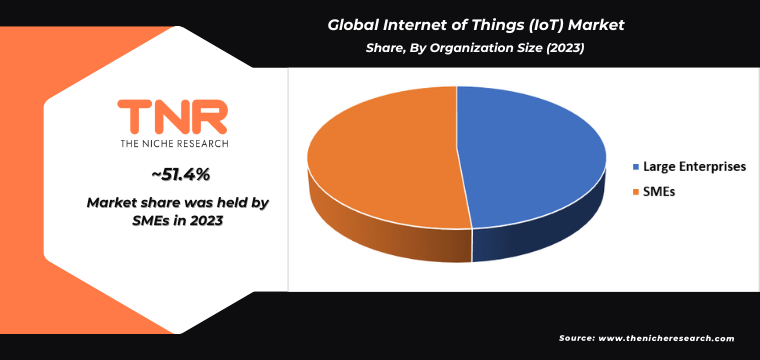
By Component Services Segment is Projected as the Fastest Growing Segment in the Global Internet of Things (IoT) Market During the Forecasted Period.
The demand for IoT-enabled services is burgeoning across industries as organizations capitalize on the transformative capabilities of connected devices. In sectors such as healthcare, IoT facilitates remote patient monitoring, personalized care delivery, and predictive maintenance of medical equipment, enhancing patient outcomes and operational efficiencies. In retail, IoT enhances customer experiences through personalized marketing, inventory management optimization, and real-time analytics for decision-making.
Moreover, in smart cities, IoT sensors and data analytics improve public services like transportation management, energy efficiency, and waste management, fostering sustainability and quality of life. The demand for IoT services is driven by the quest for operational efficiency, cost savings, and enhanced customer satisfaction. As connectivity technologies like 5G continue to advance, enabling faster data transmission and lower latency, the potential for IoT to revolutionize service delivery and create new business models grows, propelling its adoption globally.
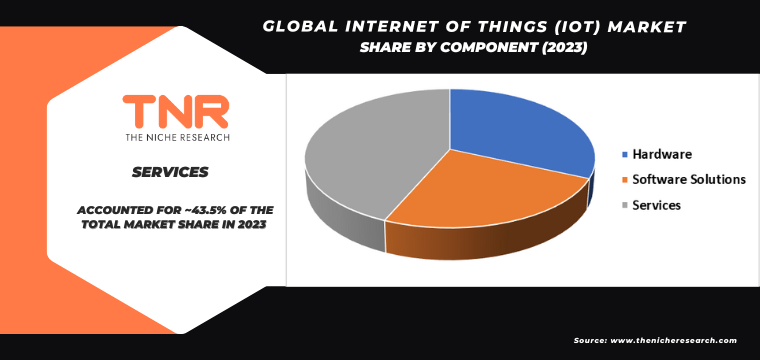
By Focus Area Smart Manufacturing had the Highest Share in the Global Internet of Things (IoT) Market in 2023.
Smart manufacturing, empowered by the Internet of Things (IoT), is driving significant demand by revolutionizing industrial processes with enhanced efficiency, productivity, and cost-effectiveness. IoT-enabled sensors, actuators, and connected devices enable real-time monitoring and control of manufacturing operations, optimizing asset utilization and minimizing downtime. Predictive maintenance, facilitated by IoT data analytics, prevents equipment failures and reduces maintenance costs.
Additionally, IoT facilitates seamless integration across the supply chain, enhancing supply chain visibility, inventory management, and logistics efficiency. The demand for smart manufacturing solutions is further propelled by the increasing adoption of Industry 4.0 principles, which emphasize automation, data exchange, and digital technologies. In Europe, smart manufacturing initiatives are bolstered by supportive government policies, funding for digital transformation, and a skilled workforce, driving the region’s leadership in adopting IoT technologies for industrial innovation and competitiveness on a global scale.
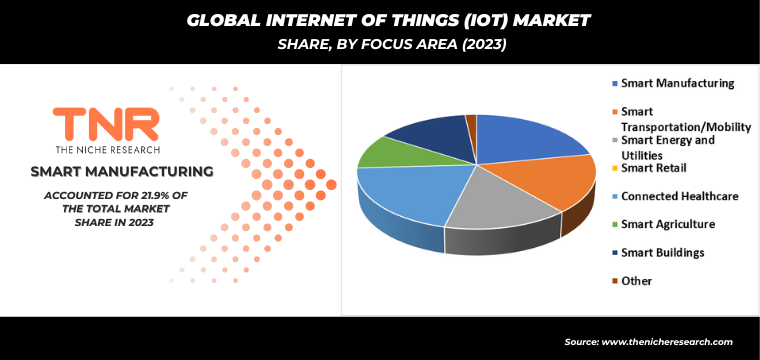
By Region, North America Dominated the Global Internet of Things (IoT) Market in 2023.
In North America, the integration of IoT devices, such as wearable health monitors, remote patient monitoring systems, and smart medical devices, enhances healthcare delivery by enabling real-time data collection, remote patient management, and predictive analytics. These capabilities are particularly beneficial in improving chronic disease management, optimizing hospital operations, and enhancing patient outcomes through proactive and personalized care strategies. The region’s robust technological infrastructure, coupled with high adoption rates of IoT solutions by healthcare providers and institutions, drives innovation and investment in IoT-enabled healthcare technologies.
Additionally, regulatory support and favorable reimbursement policies further accelerate the deployment of IoT in healthcare settings, fostering a conducive environment for growth and advancement in North America’s healthcare IoT market. In Europe, the Internet of Things (IoT) market is experiencing robust growth, driven by increasing adoption across various sectors including manufacturing, healthcare, transportation, and agriculture. Moreover, initiatives by European governments and industries to promote digital transformation and smart city projects further propel IoT adoption. Countries like Germany, the UK, and France are leading in IoT deployment, leveraging these technologies to improve efficiency, productivity, and sustainability across various sectors, solidifying Europe’s position as a key player in the global IoT landscape.
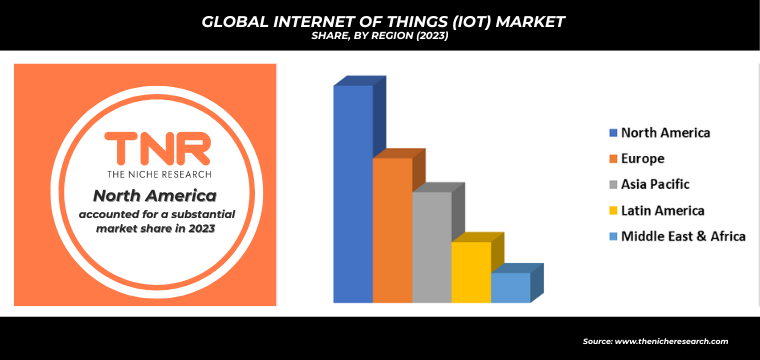
Competitive Landscape: Global Internet of Things (IoT) Market:
- Amazon Web Services, Inc.
- Intel Corporation
- Microsoft Corporation
- PTC Inc.
- GE
- Cisco Systems, Inc.
- IBM Corporation
- Oracle Corporation
- SAP SE
- Siemens AG
- Other Industry Participants
Global Internet of Things (IoT) Market Scope
| Report Specifications | Details |
| Market Revenue in 2023 | US$ 304.7 Bn |
| Market Size Forecast by 2034 | US$ 1,589.1 Bn |
| Growth Rate (CAGR) | 16.2% |
| Historic Data | 2016 – 2022 |
| Base Year for Estimation | 2023 |
| Forecast Period | 2024 – 2034 |
| Report Inclusions | Market Size & Estimates, Market Dynamics, Competitive Scenario, Trends, Growth Factors, Market Determinants, Key Investment Segmentation, Product/Service/Solutions Benchmarking |
| Segments Covered | By Component, By Organization Size, By Focus Area, By Region |
| Regions Covered | North America, Europe, Asia Pacific, Middle East & Africa, Latin America |
| Countries Covered | U.S., Canada, Mexico, Rest of North America, France, The UK, Spain, Germany, Italy, Nordic Countries (Denmark, Finland, Iceland, Sweden, Norway), Benelux Union (Belgium, The Netherlands, Luxembourg), Rest of Europe, China, Japan, India, New Zealand, Australia, South Korea, Southeast Asia (Indonesia, Thailand, Malaysia, Singapore, Rest of Southeast Asia), Rest of Asia Pacific, Saudi Arabia, UAE, Egypt, Kuwait, South Africa, Rest of Middle East & Africa, Brazil, Argentina, Rest of Latin America |
| Key Players | Amazon Web Services, Inc., Intel Corporation, Microsoft Corporation, PTC Inc., GE, Cisco Systems, Inc., IBM Corporation, Oracle Corporation, SAP SE, Siemens AG |
| Customization Scope | Customization allows for the inclusion/modification of content pertaining to geographical regions, countries, and specific market segments. |
| Pricing & Procurement Options | Explore purchase options tailored to your specific research requirements |
| Contact Details | Consult With Our Expert
Japan (Toll-Free): +81 663-386-8111 South Korea (Toll-Free): +82-808- 703-126 Saudi Arabia (Toll-Free): +966 800-850-1643 United Kingdom: +44 753-710-5080 United States: +1 302-232-5106 E-mail: askanexpert@thenicheresearch.com
|
Global Internet of Things (IoT) Market
By Component
- Hardware
- Software Solutions
- Smart Surveillance
- Data Management
- Device Management
- Application Management
- Network Management
- Services
- Professional Services
- Consulting
- Implementation
- Support and Maintenance
- Managed Services
- Professional Services
By Organization Size
- Large Enterprises
- SMEs
By Focus Area
- Smart Manufacturing
- Asset Tracking and Remote Management
- Production Optimization
- Workforce Management
- Smart Transportation/Mobility
- Traffic Management
- Cargo Monitoring
- Fleet Management
- Ticekting and Toll Collection
- Smart Energy and Utilities
- Energy Efficiency
- Energy Consumption
- Energy Transmission and Distribution
- Smart Retail
- Geomarketing and Advertising
- Smart Payment and Customer Experience
- Connected Healthcare
- Telemedicine
- Clinical Operations Management
- Imaging and Diagnostics
- Smart Agriculture
- Fleet and Crop Monitoring
- Weather Monitoring
- Smart Buildings
- Identity and Access Management
- Smart Water Management
- Automation and Control
- Other
By Region
- North America (U.S., Canada, Mexico, Rest of North America)
- Europe (France, The UK, Spain, Germany, Italy, Nordic Countries (Denmark, Finland, Iceland, Sweden, Norway), Benelux Union (Belgium, The Netherlands, Luxembourg), Rest of Europe)
- Asia Pacific (China, Japan, India, New Zealand, Australia, South Korea, Southeast Asia (Indonesia, Thailand, Malaysia, Singapore, Rest of Southeast Asia), Rest of Asia Pacific)
- Middle East & Africa (Saudi Arabia, UAE, Egypt, Kuwait, South Africa, Rest of Middle East & Africa)
- Latin America (Brazil, Argentina, Rest of Latin America)
Report Layout:
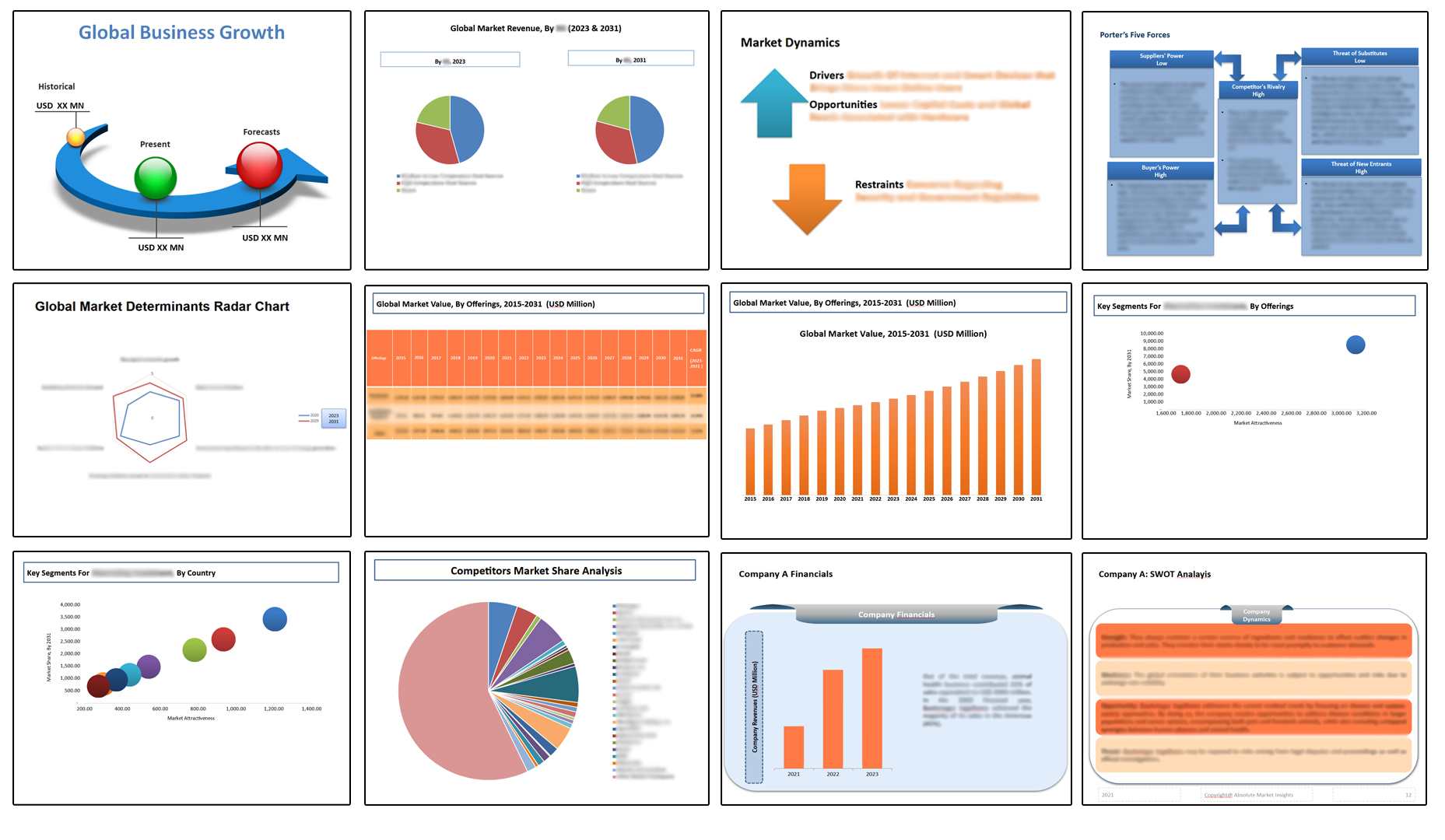
Table of Contents
Note: This ToC is tentative and can be changed according to the research study conducted during the course of report completion.
**Exclusive for Multi-User and Enterprise User.
Global Internet of Things (IoT) Market
By Component
- Hardware
- Software Solutions
- Smart Surveillance
- Data Management
- Device Management
- Application Management
- Network Management
- Services
- Professional Services
- Consulting
- Implementation
- Support and Maintenance
- Managed Services
- Professional Services
By Organization Size
- Large Enterprises
- SMEs
By Focus Area
- Smart Manufacturing
- Asset Tracking and Remote Management
- Production Optimization
- Workforce Management
- Smart Transportation/Mobility
- Traffic Management
- Cargo Monitoring
- Fleet Management
- Ticekting and Toll Collection
- Smart Energy and Utilities
- Energy Efficiency
- Energy Consumption
- Energy Transmission and Distribution
- Smart Retail
- Geomarketing and Advertising
- Smart Payment and Customer Experience
- Connected Healthcare
- Telemedicine
- Clinical Operations Management
- Imaging and Diagnostics
- Smart Agriculture
- Fleet and Crop Monitoring
- Weather Monitoring
- Smart Buildings
- Identity and Access Management
- Smart Water Management
- Automation and Control
- Other
By Region
- North America (U.S., Canada, Mexico, Rest of North America)
- Europe (France, The UK, Spain, Germany, Italy, Nordic Countries (Denmark, Finland, Iceland, Sweden, Norway), Benelux Union (Belgium, The Netherlands, Luxembourg), Rest of Europe)
- Asia Pacific (China, Japan, India, New Zealand, Australia, South Korea, Southeast Asia (Indonesia, Thailand, Malaysia, Singapore, Rest of Southeast Asia), Rest of Asia Pacific)
- Middle East & Africa (Saudi Arabia, UAE, Egypt, Kuwait, South Africa, Rest of Middle East & Africa)
- Latin America (Brazil, Argentina, Rest of Latin America)
The Niche Research approach encompasses both primary and secondary research methods to provide comprehensive insights. While primary research is the cornerstone of our studies, we also incorporate secondary research sources such as company annual reports, premium industry databases, press releases, industry journals, and white papers.
Within our primary research, we actively engage with various industry stakeholders, conducting paid interviews and surveys. Our meticulous analysis extends to every market participant in major countries, allowing us to thoroughly examine their portfolios, calculate market shares, and segment revenues.
Our data collection primarily focuses on individual countries within our research scope, enabling us to estimate regional market sizes. Typically, we employ a bottom-up approach, meticulously tracking trends in different countries. We analyze growth drivers, constraints, technological innovations, and opportunities for each country, ultimately arriving at regional figures.Our process begins by examining the growth prospects of each country. Building upon these insights, we project growth and trends for the entire region. Finally, we utilize our proprietary model to refine estimations and forecasts.
Our data validation standards are integral to ensuring the reliability and accuracy of our research findings. Here’s a breakdown of our data validation processes and the stakeholders we engage with during our primary research:
- Supply Side Analysis: We initiate a supply side analysis by directly contacting market participants, through telephonic interviews and questionnaires containing both open-ended and close-ended questions. We gather information on their portfolios, segment revenues, developments, and growth strategies.
- Demand Side Analysis: To gain insights into adoption trends and consumer preferences, we reach out to target customers and users (non-vendors). This information forms a vital part of the qualitative analysis section of our reports, covering market dynamics, adoption trends, consumer behavior, spending patterns, and other related aspects.
- Consultant Insights: We tap into the expertise of our partner consultants from around the world to obtain their unique viewpoints and perspectives. Their insights contribute to a well-rounded understanding of the markets under investigation.
- In-House Validation: To ensure data accuracy and reliability, we conduct cross-validation of data points and information through our in-house team of consultants and utilize advanced data modeling tools for thorough verification.
The forecasts we provide are based on a comprehensive assessment of various factors, including:
- Market Trends and Past Performance (Last Five Years): We accurately analyze market trends and performance data from preceding five years to identify historical patterns and understand the market’s evolution.
- Historical Performance and Growth of Market Participants: We assess the historical performance and growth trajectories of key market participants. This analysis provides insights into the competitive landscape and individual company strategies.
- Market Determinants Impact Analysis (Next Eight Years): We conduct a rigorous analysis of the factors that are projected to influence the market over the next eight years. This includes assessing both internal and external determinants that can shape market dynamics.
- Drivers and Challenges for the Forecast Period:Identify the factors expected to drive market growth during the forecast period, as well as the challenges that the industry may face. This analysis aids in deriving an accurate growth rate projection.
- New Acquisitions, Collaborations, or Partnerships: We keep a close watch on any new acquisitions, collaborations, or partnerships within the industry. These developments can have a significant impact on market dynamics and competitiveness.
- Macro and Micro Factors Analysis:A thorough examination of both macro-level factors (e.g., economic trends, regulatory changes) and micro-level factors (e.g., technological advancements, consumer preferences) that may influence the market during the forecast period.
- End-User Sentiment Analysis: To understand the market from the end-user perspective, we conduct sentiment analysis. This involves assessing the sentiment, preferences, and feedback of the end-users, which can provide valuable insights into market trends.
- Perspective of Primary Participants: Insights gathered directly from primary research participants play a crucial role in shaping our forecasts. Their perspectives and experiences provide valuable qualitative data.
- Year-on-Year Growth Trend: We utilize a year-on-year growth trend based on historical market growth and expected future trends. This helps in formulating our growth projections, aligning them with the market’s historical performance.
Research process adopted by TNR involves multiple stages, including data collection, validation, quality checks, and presentation. It’s crucial that the data and information we provide add value to your existing market understanding and expertise. We have also established partnerships with business consulting, research, and survey organizations across regions and globally to collaborate on regional analysis and data validation, ensuring the highest level of accuracy and reliability in our reports.









